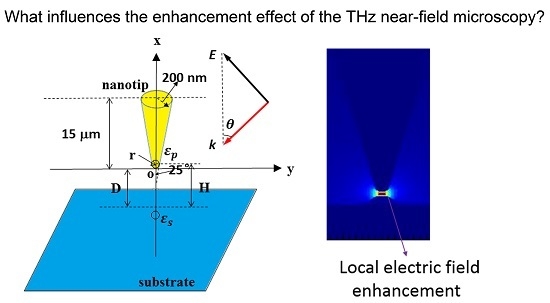Enhancement Effects of the Terahertz Near-Field Microscopy
Abstract
:1. Introduction
2. Simulation Methods

3. Results and Discussion
3.1. Effect of the Radius of the Apex of the Nanotip

3.2. Effect of the Metal Substrate

3.3. Effect of the Dielectric Properties of the Nanotip and Substrate

3.4. Effect of the Detected Sample

| Substrate | E (V/m) | ||||
|---|---|---|---|---|---|
| Air | Si | Au | PEC | InSb | |
| Au | 275.8 | 632.2 | 740.9 | 759.6 | 800.7 |
| Si | 189.4 | 365.2 | 415.0 | 416.0 | 437. 7 |
4. Conclusions
Acknowledgments
Author Contributions
Conflicts of Interest
References
- Xie, L.J.; Yao, Y.; Ying, Y.B. The application of terahertz spectroscopy to protein detection: A review. Appl. Spectrosc. Rev. 2014, 49, 448–461. [Google Scholar] [CrossRef]
- Eifert, A.; Kranz, C. Hyphenating atomic force microscopy. Anal. Chem. 2014, 86, 5190–5200. [Google Scholar] [CrossRef] [PubMed]
- Huber, A.J.; Keilmann, F.; Wittborn, J.; Aizpurua, J.; Hillenbrand, R. Terahertz near-field nanoscopy of mobile carriers in single semiconductor nanodevices. Nano Lett. 2008, 8, 3766–3770. [Google Scholar] [CrossRef] [PubMed]
- Adam, A.J.L. Review of near-field terahertz measurement methods and their applications how to achieve sub-wavelength resolution at their frequencies. J. Infrared Millimeter Terahertz Waves 2011, 32, 976–1019. [Google Scholar] [CrossRef]
- Ishihara, K.; Ohashi, K.; Ikari, T.; Minamide, H.; Yokoyama, H.; Shikata, J.-I.; Ito, H. Terahertz-wave near-field imaging with subwavelength resolution using surface-wave-assisted bow-tie aperture. Appl. Phys. Lett. 2006, 89, 201120. [Google Scholar] [CrossRef]
- Pohl, D.W.; Denk, W.; Lanz, M. Optical stethoscopy: Image recording with resolution lambda/20. Appl. Phys. Lett. 1984, 44, 651–653. [Google Scholar] [CrossRef]
- Michaels, C.A.; Stranick, S.J.; Richter, L.J.; Cavanagh, R.R. Scanning near-field infrared microscopy and spectroscopy with a broadband laser source. J. Appl. Phys. 2000, 88, 4832–4839. [Google Scholar] [CrossRef]
- Zhang, R.; Zhang, Y.; Dong, Z.C.; Jiang, S.; Zhang, C.; Chen, L.G.; Zhang, L.; Liao, Y.; Aizpurua, J.; Luo, Y.; et al. Chemical mapping of a single molecule by plasmon-enhanced raman scattering. Nature 2013, 498, 82–86. [Google Scholar] [CrossRef] [PubMed]
- Huth, F.; Govyadinov, A.; Amarie, S.; Nuansing, W.; Keilmann, F.; Hilenbrand, R. Nano-FTIR absorption spectroscopy of molecular fingerprints at 20 nm spatial resolution. Nano Lett. 2012, 12, 3973–3978. [Google Scholar] [CrossRef] [PubMed]
- Mauser, N.; Hartschuh, A. Tip-enhanced near-field optical microscopy. Chem. Soc. Rev. 2014, 43, 1248–1262. [Google Scholar] [CrossRef] [PubMed]
- McLeod, A.S.; Kelly, P.; Goldflam, M.D.; Gainsforth, Z.; Westphal, A.J.; Dominguez, G.; Thiemens, M.H.; Fogler, M.M.; Basov, D.N. Model for quantitative tip-enhanced spectroscopy and the extraction of nanoscale-resolved optical constants. Phys. Rev. B 2014, 90, 085136. [Google Scholar] [CrossRef]
- Chen, H.T.; Kersting, R.; Cho, G.C. Terahertz imaging with nanometer resolution. Appl. Phys. Lett. 2003, 83, 3009–3011. [Google Scholar] [CrossRef]
- Wächter, M.; Nagel, M.; Kurz, H. Tapered photoconductive terahertz field probe tip with subwavelength spatial resolution. Appl. Phys. Lett. 2009, 95, 041112. [Google Scholar] [CrossRef]
- Masson, J.B.; Gallot, G. True near field versus contrast near field imaging. Opt. Express 2006, 14, 11566–11574. [Google Scholar] [CrossRef] [PubMed]
- Kurihara, T.; Yamaguchi, K.; Watanabe, H.; Nakajima, M.; Suemoto, T. Dielectric probe for scattering-type terahertz scanning near-field optical microscopy. Appl. Phys. Lett. 2013, 103, 151105. [Google Scholar] [CrossRef]
- Notingher, I.; Elfick, A. Effect of sample and substrate electric properties on the electric field enhancement at the apex of SPM nanotips. J. Phys. Chem. B 2005, 109, 15699–15706. [Google Scholar] [CrossRef] [PubMed]
- Yang, Z.; Aizpurua, J.; Xu, H. Electromagnetic field enhancement in TERS configurations. J. Raman Spectrosc. 2009, 40, 1343–1348. [Google Scholar] [CrossRef]
- Knoll, B.; Keilmann, F. Near-field probing of vibrational absorption for chemical microscopy. Nature 1999, 399, 134–137. [Google Scholar] [CrossRef]
- Knoll, B.; Keilmann, F. Enhanced dielectric contrast in scattering-type scanning near-field optical microscopy. Opt. Commun. 2000, 182, 321–328. [Google Scholar] [CrossRef]
- Isaac, T.H.; Barnes, W.L.; Hendry, E. Determining the terahertz optical properties of subwavelength films using semiconductor surface plasmons. Appl. Phys. Lett. 2008, 93, 241115. [Google Scholar] [CrossRef]
- Duo, T.B.; Huang, J.; Chen, J.; Wei, D.S.; Pan, W.; Du, C.L.; Cui, H.L. Interaction between metal nanotip and substrate under terahertz wave radiation. J. Mod. Opt. 2015, 62, 644–648. [Google Scholar] [CrossRef]
© 2015 by the authors; licensee MDPI, Basel, Switzerland. This article is an open access article distributed under the terms and conditions of the Creative Commons Attribution license (http://creativecommons.org/licenses/by/4.0/).
Share and Cite
Huang, J.; Yang, Z.; Wei, D.; Du, C.; Cui, H.-L. Enhancement Effects of the Terahertz Near-Field Microscopy. Appl. Sci. 2015, 5, 1745-1755. https://doi.org/10.3390/app5041745
Huang J, Yang Z, Wei D, Du C, Cui H-L. Enhancement Effects of the Terahertz Near-Field Microscopy. Applied Sciences. 2015; 5(4):1745-1755. https://doi.org/10.3390/app5041745
Chicago/Turabian StyleHuang, Jian, Zhongbo Yang, Dongshan Wei, Chunlei Du, and Hong-Liang Cui. 2015. "Enhancement Effects of the Terahertz Near-Field Microscopy" Applied Sciences 5, no. 4: 1745-1755. https://doi.org/10.3390/app5041745
APA StyleHuang, J., Yang, Z., Wei, D., Du, C., & Cui, H. -L. (2015). Enhancement Effects of the Terahertz Near-Field Microscopy. Applied Sciences, 5(4), 1745-1755. https://doi.org/10.3390/app5041745








